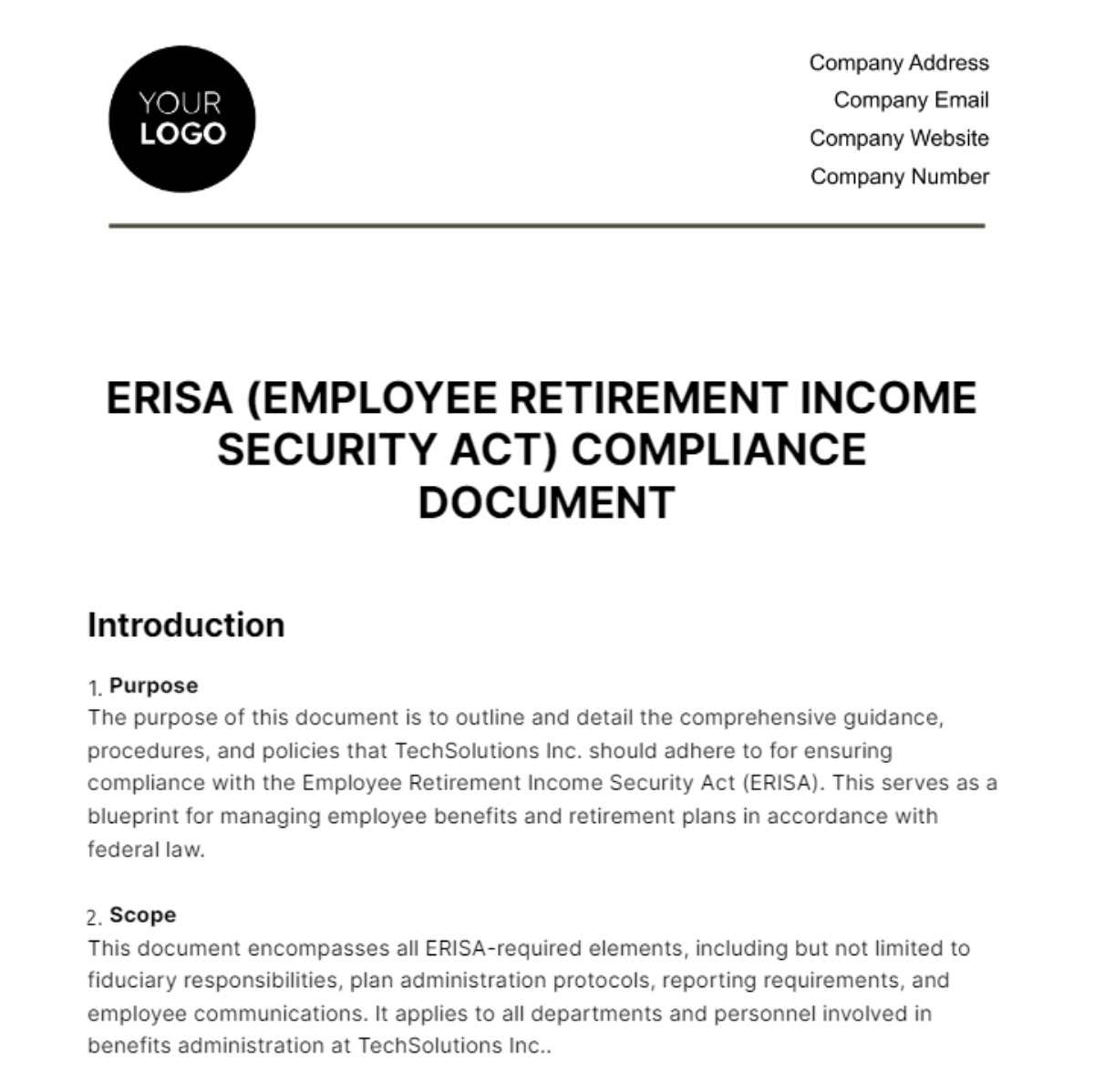Free ERISA Compliance Document HR

Introduction
Purpose
The purpose of this document is to outline and detail the comprehensive guidance, procedures, and policies that TechSolutions Inc. should adhere to for ensuring compliance with the Employee Retirement Income Security Act (ERISA). This serves as a blueprint for managing employee benefits and retirement plans in accordance with federal law.
Scope
This document encompasses all ERISA-required elements, including but not limited to fiduciary responsibilities, plan administration protocols, reporting requirements, and employee communications. It applies to all departments and personnel involved in benefits administration at TechSolutions Inc..
Audience
This document is intended for HR professionals, plan administrators, and executives within TechSolutions Inc.. It may also be shared with external auditors and legal consultants for verification and guidance.
Overview of ERISA
Brief History
The Employee Retirement Income Security Act (ERISA) was signed into law by [president’s name] on [date]. It was designed to protect employees' pension rights and has since been amended to include health care and other benefit plans.
Key Provisions
ERISA's key provisions include setting minimum standards for employee benefit plans, requiring transparency through reporting and disclosures, and imposing fiduciary duties on those who manage and control plan assets. It also offers protections for individual plan participants.
ERISA Compliance Requirements
Fiduciary Duties
As a fiduciary, TechSolutions Inc. is legally obligated to act solely in the interest of plan participants and their beneficiaries. This involves prudent management of plan assets, disclosure of financial status, and transparent operations.
Plan Administration
Effective plan administration is crucial for ERISA compliance. This includes timely distribution of benefits, keeping accurate records, and maintaining sufficient funds to meet future obligations.
Reporting and Disclosure
ERISA requires employers to submit various forms and documents, such as the annual Form 5500, to the Department of Labor (DOL). It also necessitates providing plan participants with a Summary Plan Description (SPD), detailing the benefits, limitations, and procedures of the plan.
Record-Keeping
Record-keeping is fundamental to ERISA compliance. Employers must maintain records like minutes of meetings, financial reports, and plan documents for a minimum of six years to demonstrate compliance and facilitate audits.
ERISA Compliance Checklists
Annual Requirements
Task | Due Date | Responsible Party |
Form 5500 Submission | July 31 | HR Department |
SPD Updates and Distribution | December 31 | Plan Administrator |
Annual Benefits Statement | January 31 | HR Department |
Quarterly Requirements
Task | Due Date | Responsible Party |
Quarterly Benefits Statement | Quarterly | HR Department |
Fiduciary Review Meetings | Quarterly | Plan Administrator |
Compliance Monitoring
Audit Process
Regular audits, both internal and external, should be conducted at least once a year to verify ERISA compliance. This includes reviewing plan documents, records, and reports to ensure that they meet the set standards.
Violations and Penalties
ERISA violations can result in severe penalties, including monetary fines and legal consequences. In extreme cases, failure to comply can lead to criminal charges. The responsibility for these violations primarily lies with the fiduciaries and plan administrators.
Employee Communication
Summary Plan Descriptions (SPD)
SPDs must be made available to employees within 90 days of joining the plan. These documents should provide detailed information about how the plan works, benefits, and how to file a claim for those benefits.
Employee Training
Training sessions should be conducted annually to educate employees about their rights and responsibilities under ERISA. This will also serve as an opportunity for employees to ask questions and clarify any doubts they might have.
Conclusion
Consistent adherence to ERISA guidelines is vital for protecting both the company and its employees. It is not just a legal requirement, but a commitment by TechSolutions Inc. to provide a secure and transparent benefit plan to its workforce.
For further information, queries, or clarifications, please reach out to the Human Resources department via TechSolutions@email.com or follow us on www.techsolutionsinc.com/twitter for updates.
This document is intended as a guideline and is not meant to replace professional legal advice. For detailed legal obligations and requirements, it is advisable to consult with qualified ERISA professionals.
- 100% Customizable, free editor
- Access 1 Million+ Templates, photo’s & graphics
- Download or share as a template
- Click and replace photos, graphics, text, backgrounds
- Resize, crop, AI write & more
- Access advanced editor
Ensure compliance with the Employee Retirement Income Security Act (ERISA) using our ERISA Compliance Document HR Template. This comprehensive guide outlines the essential components required for ERISA compliance, including plan details, participant rights, and reporting obligations. It's an invaluable resource for HR professionals and benefits administrators to safeguard employee retirement benefits. Secure your copy today and meet your ERISA compliance obligations effectively.





























